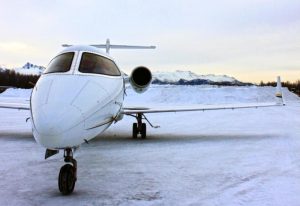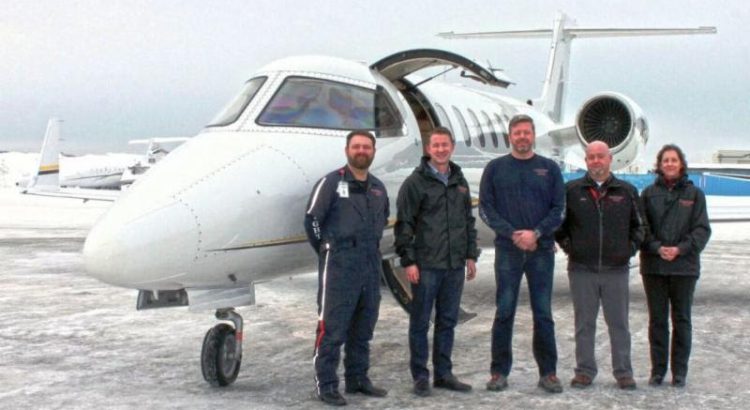 Guardian Flight LLC, a leading air medical transport company, is transitioning its medical jet fleet in Alaska to Learjet 45s. The first Learjet 45 will enter service this month based in Fairbanks.
Guardian Flight LLC, a leading air medical transport company, is transitioning its medical jet fleet in Alaska to Learjet 45s. The first Learjet 45 will enter service this month based in Fairbanks.
Eventually, five Learjet 45s will replace Guardian Flight’s older and smaller Learjet 35s and Beechjets. Compared to the smaller jets, the mid-size Learjet 45s will provide better reliability, improved flight performance and braking, increased parts availability and more modern avionics for better cockpit standardization and less pilot workload.
In addition, Learjet 45s have a slower approach and circling speed than Learjet 35s. That will allow Guardian Flight pilots to attempt approaches into airports with lower cloud ceilings and lower visibility requirements than with the Learjet 35s in the past.
The change will also make circling approaches into some airports practical in situations where they have not been before. Learjet 45s have a larger cabin for improved patient care and family escort capabilities, medical staff performance and equipment storage.
Guardian Flight President and Air Medical Group Holdings (AMGH) CEO Fred Buttrell said, “AMGH purchased the Guardian Flight operation with the intention of improving the medical jet fleet to deliver better air medical transportation and care for Alaskans. This boost to fleet performance and medical care represents our goal of providing the best servant care for Alaska patients 24 hours a day, seven days a week.”
Alaska Bases
Four of the newer Learjet 45s will be housed at bases in Fairbanks, Ketchikan, Anchorage and Juneau. The fifth Learjet 45 will operate as a backup when aircraft are out of service for routine maintenance or to meet higher flight requirements during times of higher demand.
Guardian Flight Alaska’s Chief Pilot Tim Manier said, “Our Learjet pilots are receiving training in the Learjet 45s at FlightSafety International’s base in Tucson, Ariz. We anticipate that the fleet transition to Learjet 45s will be complete by mid-summer provided the FAA can maintain its schedule on conformity and operational specifications.”
Guardian Flight contracted with Fargo Jet Center in Fargo, N.D. to convert the aircraft interior from passenger to medical configuration. The Guardian Flight Anchorage base serves as a maintenance hub for the company’s Learjet fleet in Alaska.
Alaska Fleet
In addition to the five Guardian Flight jets flying later this year, the company also operates a fleet of 10 Beechcraft King B200s and a Cessna Caravan in Alaska. Guardian Flight employs more than 50 pilots for its Alaska operations, and a highly qualified medical staff consisting of flight nurses and paramedics.
Guardian Flight, recently acquired by AMGH, operates a fleet of approximately 85 fixed and rotor wing aircraft dedicated to air medical flights in the Upper Midwest, Mountain West, Southwest, Alaska and Hawaii. With more than 800 professional staff, including clinical providers, pilots, mechanics, trained communicators and support staff, Guardian Flight’s aircraft and associated medical crews are at 54 bases in 13 states that serve a total of 15 states.
Guardian Flight companies include Eagle Air Med serving parts of Arizona, New Mexico, South Dakota, Colorado and Utah; Hawaii Life Flight in Hawaii; Guardian Flight in Alaska and Wyoming. Companies also include Gallup Med Flight and MedStar in New Mexico; Valley Med Flight in North Dakota, Michigan, Montana, and Minnesota; Alaska Regional LifeFlight in Alaska; MountainStar AirCare operating in Utah; North Central AirCare in northern Ohio and AeroCare Medical Transport serving in Arizona and New Mexico. For information on Guardian Flight LLC go to www.guardianflight.com.
Guardian Flight’s parent company, AMGH, is an industry leader in aviation safety with standards that exceed FAA and other regulatory agency minimums for training and aircraft equipment. AMGH is the country’s largest provider of emergent air medical services with more than 100,000 patient transports annually. Across the country, the company has more than 330 air base locations in 38 states with a fleet of more than 400 aircraft. Its team of more than 7,000 professionals is focused on safely transporting and caring for critically ill patients 24/7/365.



